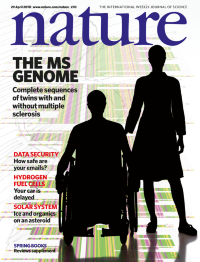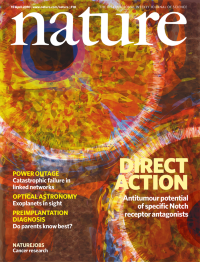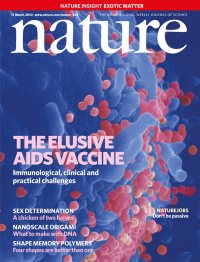Volume 464
-
No. 7293 29 April 2010
A study of three pairs of monozygotic (so-called 'identical') twins, in which one twin had multiple sclerosis and the other did not, reveals no genetic, epigenetic or transcriptome differences to explain why one twin had the disease and the other did not. Digging deeper into the data with expression quantitative trait locus mapping revealed tantalizing differences within twin pairs that merit closer examination. And some possible causes can be ruled out. Cover graphics: Fotolia/ Jorge Oksenberg
-
No. 7292 22 April 2010
The generation of complex colour patterns on animals' bodies is thought to depend on reaction-diffusion mechanisms involving diffusible local activators (morphogens) and long-range inhibitors. Using the spectacular polka-dot wing pattern of Drosophila guttifera as a model, Sean Carroll and colleagues show experimentally that the wing spots are induced by the Wingless morphogen. In composite cover image, the left wing is wild-type D. guttifera, showing the sixteen vein-associated spots and four intervein shades, and the right a double-transgenic variant, merging vein spot and intervein shade cis-regulatory element activity. Image by Thomas Werner, Shigeyuki Koshikawa and Nicolas Gompel
-
No. 7291 15 April 2010
Notch receptors are widely expressed transmembrane proteins through which mammalian cells communicate to regulate cell fate and growth, and defects in Notch signalling are linked to many cancers. Using phage display technology, a multi-department team at Genentech has produced synthetic antibodies that act as potent and specific antagonists of Notch1 and Notch2. The cover, by Gregóire Vion of Salamander Design Studios (www.grgwr.com), depicts communication between a ligand-expressing cell (right) stimulating Notch signalling in an adjacent cell. The receptor-cell membrane expresses Notches 1 and 2 (red and blue); action of a specific antagonist means that only the blue signal is transduced to the nucleus.
-
No. 7290 8 April 2010
The availability of miniature 'backpack-style' GPS loggers means it is now possible to track individual birds in a flock, and to answer the long-standing question of how birds fly in formation. Experiments on flocks of homing pigeons reveal that a bird's position in the flight depends on its place in a well-defined social hierarchy - an airborne 'pecking order'. The cover composite represents the birds' actual trajectories coloured according to leadership rank: those near the red end of the spectrum at the top of the hierarchy and those near the violet at the bottom. Cover graphics: Mate Nagy/images: Simon Walker.
-
No. 7289 1 April 2010
The working draft of the human genome sequence was released nearly 10 years ago, with the much-heralded announcement of its completion taking place in June 2000. For much of the decade, casual observers might have wondered what all the fuss was about. But the biology and technology were developing all the time, and with the recent publication of a series of major genome-wide association studies, a flood of human sequences and the advent of 'personal genomics', it's a good time to take stock. See the Editorial for a full list of human genome features in this issue, and the web special on www.nature.com/humangenome. To tell us what you think the human genome's greatest impact has been complete our survey (go.nature.com/KL4gK1) by 30 April. Cover illustration by Jonathan Burton
-
No. 7288 25 March 2010
Elemental mapping of individual atoms of carbon (yellow in the cover image) and oxygen (blue) substituted in a boron nitride monolayer (B, red; N, green) has been achieved using annular dark-field (ADF) imaging in an aberration-corrected scanning transmission electron microscope optimized for low voltage operation. The new technique, developed by Ondrej Krivanek and co-workers, should find application in materials analysis for the imaging and identification of all individual atoms in non-periodic solids.
Insight
-
No. 7287 18 March 2010
Scientific evidence, now commonplace in court, is still a constant source of controversy. A series of features and opinion pieces in this issue tackles the broad theme of how to put the science back into forensic science, from the old (fingerprints) to the very new (fMRI scanning). Credit: Sean Ellis/Getty Images/Artwork: Paul Jackman.
-
No. 7286 11 March 2010
The scanning electron micrograph on the cover, courtesy of Olivier Schwartz of the Pasteur Institute, shows HIV particles (pink pseudocolour) budding at the surface of an infected lymphocyte (blue). Reviews and features in this issue report on progress towards the elusive goal of an effective AIDS vaccine, essential if the AIDS/HIV pandemic is to be contained and HIV-1 eradicated.
Insight
-
No. 7285 4 March 2010
The international MetaHIT (Metagenomics of the Human Intestinal Tract) project has published a gene catalogue of the human gut microbiome derived from 124 healthy, overweight and obese human adults, as well as inflammatory disease patients, from Denmark and Spain. The data provide the first insights into this gene set - over 150 times larger than the human gene complement - and permit the definition of both a minimal gut metagenome and a minimal gut bacterial genome. Credit: Roger Harris /Science Photo Library.









